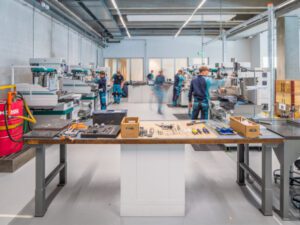International Confectionery’s Technical Editor, Clay Gordon, looks into manufacturing cacao and the different methods of processing them to achieve alt.Chocolate.
I would submit, when most people think about challenges the cacao to chocolate supply web is facing these days, that issues including illegal child labour and trafficking, farmer livelihoods, de/reforestation, and mitigating the effects of climate change are front of mind. Researching ways to supplement the cocoa supply in a lab or factory? Manufacturing alternatives to cacao in a lab? Not so much.
Despite this disconnect, there has been a small handful of very public announcements recently about research asking the question, “It is possible to manufacture analogues to cacao that will result in products that actually taste like a chocolate made from tree-grown beans?”
Not surprisingly, controversy has arisen around this research, fuelled, in part, by the way the research has been reported. Half of the articles appear to have been penned by reporters without much understanding of either cocoa or chocolate, while the other half seem to have been penned by authors supporting a shaky status quo, seeking to poison the well against investor and consumer acceptance before these lab-scale projects can even make it to industrial-scale production. Neither of these approaches addresses, seriously, the potential that the technologies suggest. Potential that deserves to be explored and brought to market.
Before addressing the potential impact of the research and the responses to it, it makes sense to get a grounding in the work itself, which is split between two general approaches: culturing and fermentation.
Culturing
This is the approach taken by US-based California Cultured and the Zurich Institute of Applied Sciences. Culturing takes actual cacao biomass – from living cacao seeds, tree, or pod tissue – and grows from them, under carefully controlled conditions, an intermediate substance (called callus) that forms the basis of the production of the cacao analogue. At present, culturing does not produce the necessary amounts lipids (fats) and so cocoa butter pressed from cocoa beans must be added when making chocolate. However, culturing can be used to produce large quantities of compounds associated with the health-giving properties of chocolate, such as procyanidins, or the stimulant theobromine, not just a cacao powder equivalent from which chocolate can be made. There are techniques to extract these valuable chemicals from actual cocoa – but perhaps that cocoa would find a better use as liquor, powder, butter, or chocolate.
Fermentation
This is the approach being pursued by UK-based WNWN (Waste Not Want Not) and Munich-based NxFoods/Qoa Company. Fermentation uses a selection of yeasts and other microbes to convert a feedstock, which does not need to be derived from cacao, into substances that have the flavour precursor components and the physical properties of fermented cacao. By changing the yeasts involved it is possible to ferment enough lipids so conventional cocoa butter is not required to make an alt.chocolate.
All the research into culturing and fermentation is lab-scale at the moment. While the disparate approaches have been proven to work, within limits, there is still much work and investment that needs to be done to prove that processes that work at producing tens of kilograms can be scaled to efficiently produce tens or even hundreds of thousands of tonnes cost effectively.
Early responses to news reports I have read so far tend to fall into the following buckets.
It’s not – and never will be – “real” chocolate. This is a polite way of saying that chocolate derived from fermentation or culturing is now, and always will be, “fake” and for that reason alone, the research is not worth pursuing.
People have been levelling this criticism against chocolate-like substances, including carob for decades. There are also many who still declaim, incorrectly, that white chocolate isn’t really chocolate. [The FDA published a final rule in the Federal Register (67 FR 62171) that established a standard of identity for white chocolate in October 2002, and the final rule became effective on January 1, 2004 – keep in mind that white chocolate was invented in the late 1930s so the standard of identity adoption process can take a while.] Also think about what is often commonly called “compound chocolate” and is legally called “sweet chocolate and vegetable fat coating” (CFR 21 §163.153). So, in actual fact, government entities define into existence what chocolate is and is not and those definitions are subject to change.
What is more important, when it comes to this argument, is to address two lines of questions.
First, does the alt.chocolate actually taste, melt, and otherwise behave like a chocolate made from cacao grown on trees? Here, a “Turing test” seems appropriate: If someone eats a piece of alt.chocolate and it is indistinguishable to the senses from “real” chocolate – what then?
Second, is this a disclosure issue that can be addressed through labelling regulations? There has been strong industry pushback by the US dairy industry against using the word “milk” to describe alt.milks made from cereal grains, seeds, and nuts. Is a consumer really confused about the source of what they’re putting in their coffee when the container says ‘Oat Milk’ on the front? Often, chocolate makers will label chocolates made with non-dairy milks as ‘mylk chocolate’ so there is neither confusion nor contradiction with the standard of identity for milk chocolate. There is more than enough precedent here to easily accommodate alt.chocolates.
It’s a Frankenstein’s monster disguised as chocolate. This line of argument plays to people’s fears about genetically modified and other lab “grown” foods. This is in fact not the case with either fermentation or culturing.
Many people regularly consume fermented foods – from sourdough to kimchi to beer and wine – without thinking about whether or not the yeasts and other microbes used or the ingredients that are being fermented could have been genetically modified. Fermenting does not necessarily involve genetic modification though myriad highly sophisticated lab techniques are routinely used to identify specific strains and isolate and purify them.
When it comes to culturing the process is better described by the term epigenetics – that is, using environmental variables (that include temperature and nutrients) to control the ways that endogenous genes express themselves, also termed upregulation and downregulation. Epigenetic changes happen inside human bodies on a regular basis and are a basic part of biology and physiology.
“culturing can produce some of the valuable botanical compounds that chocolate is famous for, compounds that are expensive to produce using conventional extraction techniques”
Both fermentation and culturing take place in bioreactors in labs and factories. To many, the word bioreactor could be scary. But in most respects, they are just specialist pressure cookers that can precisely control the environment in which the fermentation or culturing takes place. Cocoa alkalisation and cocoa butter deodorisation plants are not all that different in some respects, and people are not afraid of them, or the products manufactured in them. In fact, many common food ingredients are entirely synthetic, produced using the same kinds of equipment and many of the exact same techniques that culturing and fermentation employ.
Like a conventional chocolate factory, an alt.chocolate factory can be located anywhere in the world; they do not need to be built in a country where cacao conventionally grows. Both fermentation and culturing techniques (and others) are used in the production of alt.proteins, for example lab-grown beef and fish as well as plant-based alternatives to meat. So, there is nothing unusual or scary here or to be worried about when it comes to those same technologies and techniques being used to manufacture alt.chocolates. The only difference might be summed up by the phrase, “Don’t mess with my chocolate!”
Why? For most people, this is the main question: “Just because we can do this, should we be doing it? There’s a lot of cocoa in the world, do we need to manufacture an alternative to tree-grown cocoa in a factory?” The answers to this question are the most nuanced and will have the greatest influence, in the long run, on the course of the research, the eventual impact the work will have, and are beyond more than a cursory exploration of some of the questions that need further research.
The most oft-stated concern expressed in this area is to ask about what happens to cacao farmers? This argument is expressed most vocally by those wishing to preserve the status quo. Historically, “big chocolate” and the governments of the largest producing countries have not actually delivered on their decades-old promises to eliminate deforestation and illegal labour in the supply chain and at the same time guarantee a farm gate price that means farmers that rely on cacao are not living below the poverty line. Have alt.milks eliminated dairy farms and dairy farmers? Will alt.meats replace cattle, sheep, and pigs – or cattle farmers? Of course not. But technologies such as automated cow milking machines do necessarily change the nature of work.
alt.chocolate is not seen, by its proponents as a replacement for conventional cocoa and chocolate. alt.chocolate, is seen as a choice that can be more sustainable in the sense of lowered carbon footprint, through creating circular economies by upcycling waste from agricultural and food and beverage manufacturing, and, if a factory were to be located in a cacao-producing country, by providing well-paying non-farming jobs that require technical and managerial skill and expertise. Exporting a value-added product that does not have the percentage of waste associated with exporting beans (at least 20-25%) is not something to be tossed aside without due consideration.
alt.chocolate, is seen as a choice that can be more sustainable in the sense of lowered carbon footprint through creating circular economies by upcycling waste
Perhaps the more compelling arguments are that alt.chocolate manufacturing might help reduce deforestation pressure, reduce the use of petroleum-based agricultural chemicals, and reduce predatory purchasing practices that result in farmers receiving even less money for their work. alt.chocolate manufacturing may also help mid-market and smaller companies that do not have the R&D budgets and other resources that large companies must meet their risk assessment and mitigation requirements under proposed new EU and US ESG (environmental, social, and governance) reporting regimes, in addition to meeting any voluntary UN SDG commitments. alt.chocolate manufacturing in a balanced supply chain could also help companies meet their carbon emissions reduction goals, be a part of an active carbon sequestration (not just carbon credit trading) program and help companies in a move towards being net-zero.
In conclusion, no technology, in and of itself, is deserving of succeeding in the marketplace. To succeed in the long run, a technology needs to solve real problems that real people and companies have. Naysayers appear to be afraid of alt.food technologies when applied to chocolate but not to other foods, which is a very limiting view. alt.chocolate technologies represent real solutions to real challenges – many of them imminent existential challenges the global cocoa and chocolate industries face. It is best not to dismiss them before fully understanding their potential.
Sara & Max Marquardt, Co-Founders, NxFoods GmbH/Qoa Company says:

“Our first attempts did not taste at all like we imagined they could. There is no one single chemical in nature responsible for the aroma or taste of chocolate, there are about two dozen chemicals that need to be present in the right proportions to provide a convincing aroma and another two dozen we have to produce in order to deliver the taste people expect chocolate to taste like. The samples we first created were astringent, acidic, and bitter; in hindsight they were a lot like chocolate made from badly fermented, poorly dried, and then over-roasted cocoa. What we realized is that we needed to move our focus away from replicating the flavour of cacao and get the flavour of chocolate right. We’ve got that part down and can even ferment a cocoa butter equivalent with a specific hardness, or melting point. Now, it’s easier for us to make something that is more chocolate-forward, more like amelonado forastero grown in West Africa, than something that is predominantly fruity or floral. That’s not the focus of future research – the next stage is to demonstrate we can do all this at scale.
Our products have a total carbon footprint that is as little as 10% that of conventionally produced chocolate. Our process can take advantage of unwanted by-products of other food manufacturing processes that can be sourced locally. For every 100kg of input biomass we can produce up to 95kg of Qoa and what’s left over can be added to animal feed.
Our goal is not to replace cocoa or cocoa farmers. We see Qoa as one way to reduce the pressure to expand cacao production into new areas and thereby reduce the devastating effects of deforestation. That’s where we’re getting a lot of interest from industry, mid-market companies looking to mitigate climate risk in their cocoa supply chains.”
Alan Perlstein & Steven Stearns, Executives at California Cultured says:

“Culturing chocolate that can meet all the sensory expectations people have for it is a daunting challenge. While culturing does require starting from live tissue – from the tree, pod, or seed – we can’t take tissue from a Trinitario from Madagascar or an Ecuadorian Nacional and duplicate the flavour yet. While genetics do play a part in determining flavour potential, it would also be necessary for us to replicate the terroir of the places where the trees grow. At a minimum we’d need to mimic the micronutrient components and microbiome of the soil through the culture broth.
One of our long-term goals is to create what you could call a nature-identical chocolate, but right now we see using culturing to produce some of the valuable botanical compounds that chocolate is famous for, compounds that are expensive to produce using conventional extraction techniques.
Culturing takes advantage of the fact that changing environmental conditions influences the ways endogenous (naturally present) genes express themselves. By controlling aspects of the environment – such as temperature and macro/micronutrients – we can prod the genes responsible, say, for procyanidin production, to go into overdrive while at the same time stepping on the brakes of the genes responsible for, say caffeine production. By doing so we end up with a substance that contains high levels of the flavanols we want and little to none of chemicals we don’t want.
In that respect we are supplanting the need to extract these compounds from cocoa beans, which may require highly specific post-harvest protocols to ensure that the flavanols we want aren’t destroyed.
We also think that culturing might be a way to produce large quantities of specialty derivatives such as a defatted cocoa powder. We’d be culturing it directly, rather than fermenting and drying beans, then go through all the steps to create a low-fat cocoa powder and then chemically strip the rest of the cocoa butter out if it. By controlling the culturing process, we should be able to control the taste and colour of the powder as well without alkalisation. There are many things culturing can do besides make chocolate, and we find those possibilities worth exploring.”
Image credit: California Cultured Team
To stay up to date on the latest, trends, innovations, people news and company updates within the global confectionery market please register to receive our newsletter here
Media contact
Kiran Grewal
Editor, International Confectionery
Tel: +44 (0) 1622 823 922
Email: editor@in-confectionery.com









